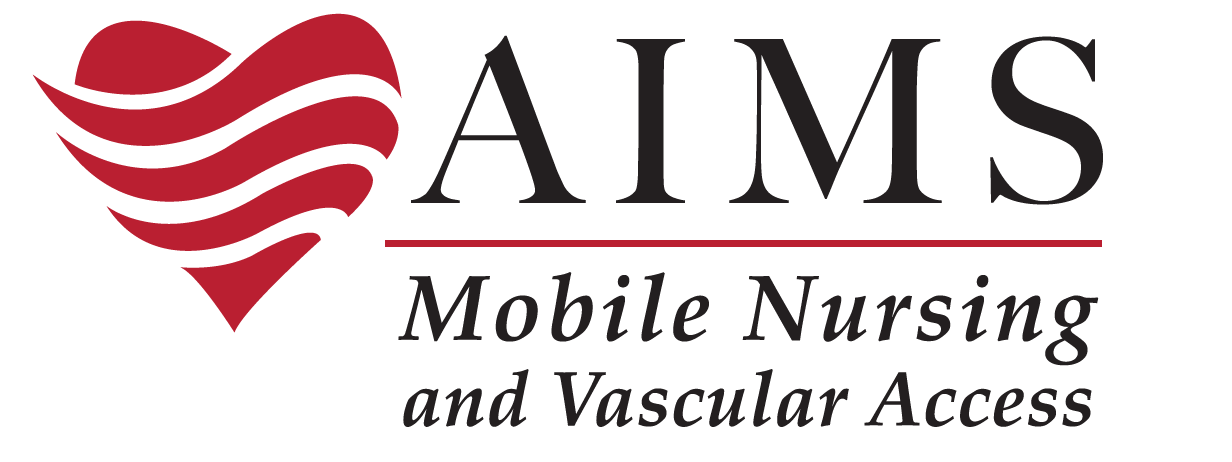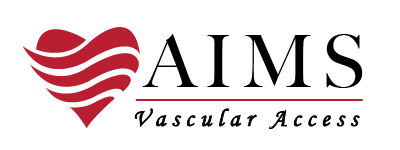By Glenda Dennis, RN, VA-BC, AIMS Founding Member
AIMS Vascular Access nurses are specially trained and will come to you in your home to administer your PICC line insertion. A PICC line insertion (peripherally inserted central catheter) administered at home saves you the expense and discomfort of having the procedure done in an institutional setting such as a hospital.
What is a PICC Line?
A PICC line is designed for people who need IV medications regularly for a period of time from 2 weeks to over a year. A PICC line insertion eliminates the need for a daily IV needle poke to administer your prescribed medications. The PICC is inserted in a vein in your upper arm using an ultrasound device to see the vein.
What is the Procedure Like?
This is a sterile procedure so your AIMS nurse will be in a sterile gown, head cover and face mask, and wearing sterile gloves. You must be lying down for the procedure.
First, your AIMS nurse covers your entire body with a sterile drape and places your arm in a way that enables them to clearly see your vein. Either arm can be used, so they examine the veins in both your arms with the ultrasound and choose the best site prior to the insertion. They numb the area with Lidocaine, and then they insert the larger needle to access the vein. This typically does not take much time, and your AIMS nurse will ask if you are uncomfortable throughout the procedure. Our goal is to keep you comfortable.
Next, your AIMS nurse inserts the catheter. This device is a long, narrow tube, typically about 20 inches (50 to 55cm) long. Occasionally, it is shorter but usually not. The goal is for the tip of the catheter to lay just outside the right atrium of the heart. The vein here is large with lots of blood flowing by, diluting the IV solution that you are receiving. Since all veins lead back to the heart, we use this “freeway” to reach the heart. This vein freeway, however, has several off-ramps. The AIMS nurse uses their equipment to try to avoid these off-ramps, but occasionally it takes a bit of effort to arrive at the desired destination.
Once your AIMS nurse finds the correct position, they apply a securement device or skin glue to help keep the PICC in position and secure any external length of catheter as well, to reduce the chance of accidentally pulling the PICC out. They then place a sterile dressing over the site. There is usually not much bleeding at the insertion site. Once your AIMS nurse caps the external part of the PICC, it is ready to use for infusions.
Caring for Your PICC Line
After every infusion or once a week, your AIMS nurse will flush the PICC with 10ccs of normal saline; replace the dressing using sterile technique; and change your needleless connectors and any other devices that connect to your PICC.
Protect your PICC. Prevent pets and/or children from pulling it out. Do not snag it on anything because, if pulled out, your AIMS nurse must perform a new PICC line insertion. Your AIMS nurse will record the external length on your chart, so it will be very clear if it has been dislodged.
What Not to Do to Your PICC Site
- Do not use your PICC arm for any needle sticks, such as a blood draw or an IV-line, or for blood pressure measurements.
- Do not wear tight-sleeved clothing or tourniquets.
- Never attempt to change the dressing yourself.
- Do not wet your PICC in the shower. Instead, cover the PICC arm with waterproof material such as plastic wrap and tape, and bathe in a tub if you have access to one. You may need assistance with this process. You can also buy waterproof covers, such as Aquaguards, online.
When to Call Your AIMS Vascular nurse
- If you notice redness, tenderness, bleeding, or leakage at your PICC site.
- For a wet, loose, or soiled dressing. Do not take off a damaged, loose, or dirty dressing. Instead, put a new dressing over the old one, and call your AIMS nurse immediately.
- If your PICC Site is leaking. Do not remove the dressing. Call your AIMS nurse right away and describe the problem. If fluid is leaking while you’re getting an infusion, check that the needleless connector is on tightly. If it still leaking, call your AIMS nurse.
Remember that your AIMS Vascular nurse’s number one mission is to support you on your health care journey. Never hesitate to contact us if you have a question or concern.
Call AIMS at (541) 505-7386 or email us for more information.

